Are you looking for a list of drawing styles?
The beauty of Midjourney is that you can invoke nearly any art style that you can think of.
And this not only includes the broader categories but also incredibly specific sub-genres that only experts would know.
In this guide, I’ll show you some of the most beautiful black and white Midjourney drawing styles out there.
Let’s dive right in.
Table of Contents Show

Like this content? Then share it!
15+ Midjourney Drawing Styles You Should Know
www.tokenizedhq.com
Here’s the answer. Great article by @ChrisHeidorn right here: https://tokenizedhq.com/midjourney-drawing-styles/
Overview of Midjourney Drawing Styles
As you already know, Midjourney is capable of generating images for nearly any art style that humanity has ever known.
It produces beautiful replicas of imagery that otherwise would take countless hours to create.
But despite the obvious benefits of tools like Midjourney, the limiting factor usually isn’t the machine but rather the human using it.
So, for example, knowing that you’d like to create an image in a pencil drawing art style is a relatively novice approach.
You’ll get a decent Midjourney drawing out of that but there’s no guarantee that it will reflect the specific style you had in mind.
The more comprehensive your knowledge about art and the associated vocabulary is, the more control you will have over the image you are trying to create.
In this guide, I cover a wide range of Midjourney drawing styles and patterns that are usually associated with black-and-white imagery.
Here are some broader categories:
- Hatching and Cross-Hatching: These styles involve creating tones and textures using parallel lines or intersecting lines. They’re great for adding depth and dimension to images.
- Circulism: This style uses tight circular patterns to create detailed textures and gradients of tone, often used in portraiture for realistic skin textures.
- Contouring: Contouring involves defining the edges and outlines of objects, emphasizing their shape and volume. It’s commonly used for producing images with a strong sense of form and depth.
- Scribbles, Squiggles & Short Dashes: These styles use loose, expressive lines to create images with a dynamic, energetic feel.
- Blending/Smudging: Blending creates smooth transitions between colors and tones, while smudging gives images a softer, dreamier quality.
- 3s, Zig Zags, Charcoal, and Marker: These styles offer unique textural and tonal possibilities, from the bold, graphic lines of marker drawings to the rich, deep tones of charcoal.
- Contour, Stippling, Sketch, Scumbling: Contour emphasizes the outlines of objects, while stippling uses dots to create tones and textures. Sketch style produces loose, expressive drawings, while scumbling involves layering and blending colors or tones to create rich textures and depth.
As you can see, not all Midjourney drawing styles are made equal, and depending on what your objective is, some styles will be more suitable than others.
So now that we’ve covered some broader categories, let’s get into concrete examples for each one of them.
Key Points (tl;dr)
- Using terms such as “pencil drawing” will produce a wide array of images that fit that description.
- However, few people know that there is an entire subset of very specific black-and-white drawing techniques that look very different from each other.
- Expanding your knowledge of art style vocabulary will greatly enhance your ability to create images with intent.
15+ Midjourney Drawing Style Prompts & Examples
The following list of Midjourney drawing styles is far from exhaustive, however, it provides a very good starting point.
By observing the images that each art style produces, you’ll have a much better idea of which words you should be using in your prompts.
Technical Drawing
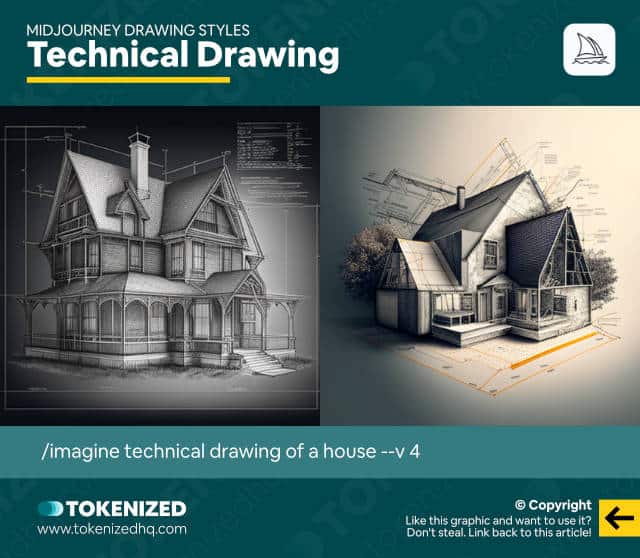
Technical drawing involves using precise measurements and drafting tools to create detailed and accurate drawings for engineering, architectural, or manufacturing purposes.
It typically includes plan, elevation, section, and detail views, as well as dimensions, annotations, and symbols.
Technical drawings often follow specific standards and conventions, such as ISO, ANSI, or ASME.
It is one of the most popular Midjourney drawing styles out there since it conveys a sense of sophisticatedness.
Sample Prompt:
/imagine technical drawing of a house --v 4Blueprint
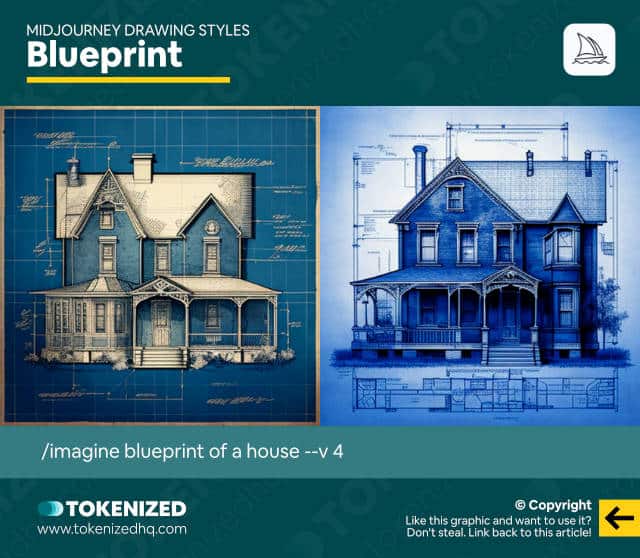
The blueprint drawing style is used to create detailed, technical drawings of buildings, machines, or objects.
The style is characterized by the use of thin, precise lines and a blue background.
Blueprints are created through a process called cyanotype, which involves using chemicals to produce blue and white prints.
This style is commonly used in architecture, engineering, and industrial design.
Sample Prompt:
/imagine blueprint of a house --v 4Hatching
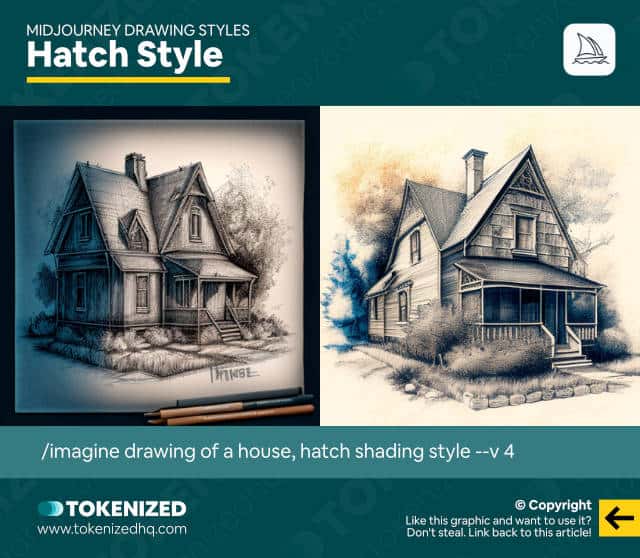
Hatching is a drawing technique where closely spaced parallel lines are used to create shading and texture in an image.
The density, angle, and direction of the lines can be adjusted to create a variety of effects.
This style is commonly used in pencil or pen and ink drawings to create depth and tonal contrast and is an excellent Midjourney drawing style as well.
Sample Prompt:
/imagine drawing of a house, hatch shading style --v 4Cross-Hatching
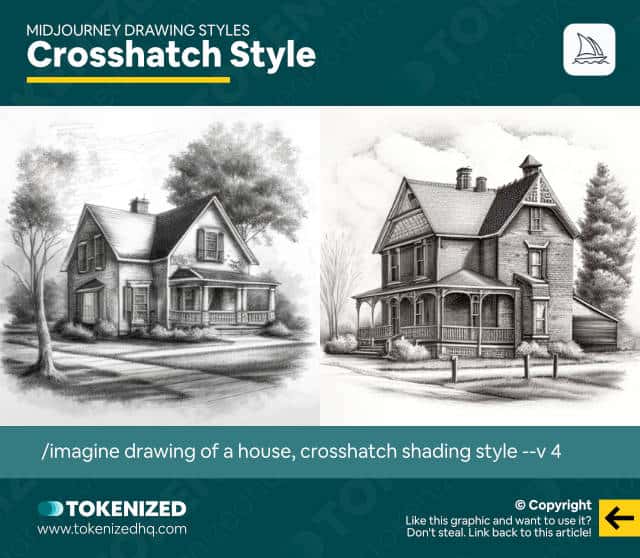
“Hatching” and “cross-hatching” are both techniques used in drawing and involve creating a series of closely spaced parallel lines to create shading or texture in an image.
Cross-hatching uses two or more sets of parallel lines that intersect to create a denser shading effect, while hatching only uses one set of parallel lines.
Sample Prompt:
/imagine drawing of a house, crosshatch shading style --v 4Circulism
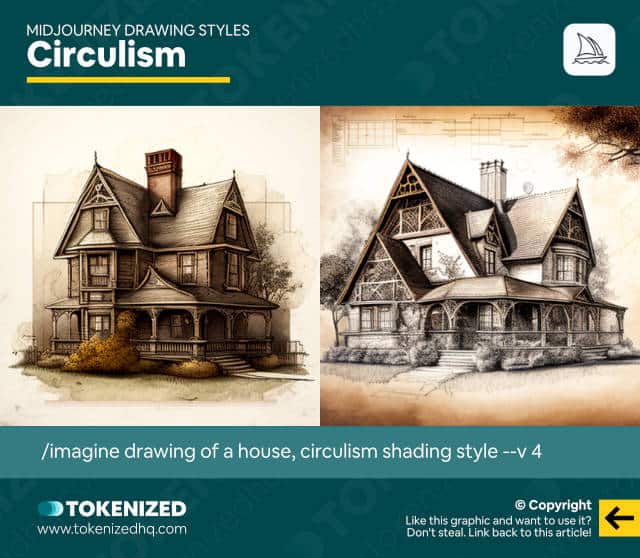
Circulism is a technique used in drawing to create smooth shading and texture.
It involves creating small, overlapping circles with a pencil or pen to build up value and tone.
This technique is often used in portraiture and is therefore especially effective as a Midjourney drawing style for capturing skin tones and textures.
Sample Prompt:
/imagine drawing of a house, circulism shading style --v 4Scribbles
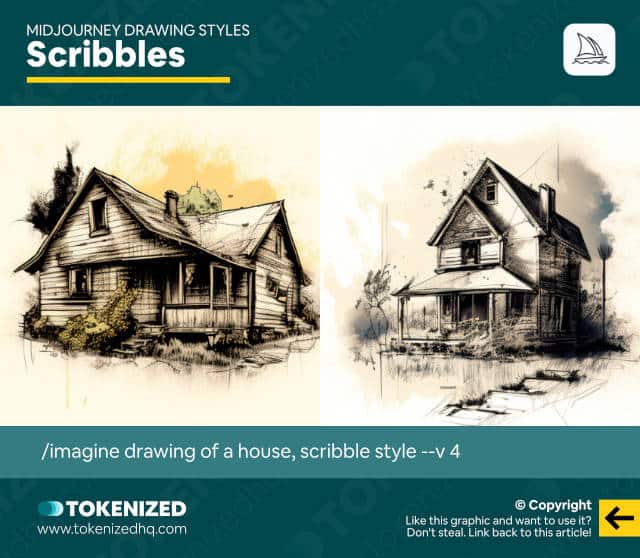
The “scribbles” drawing style is characterized by quick and spontaneous marks made with a pen or pencil.
The lines are usually drawn in a chaotic, random pattern with no apparent structure.
Scribbles are often used to convey movement, texture, or shading in a drawing.
The style is popular among artists who want to create a rough, unfinished look in their work.
Scribbles can be used to create a sense of depth and dimensionality in a drawing and is a Midjourney drawing style that you should definitely add to your arsenal.
Sample Prompt:
/imagine drawing of a house, scribble style --v 4Squiggles
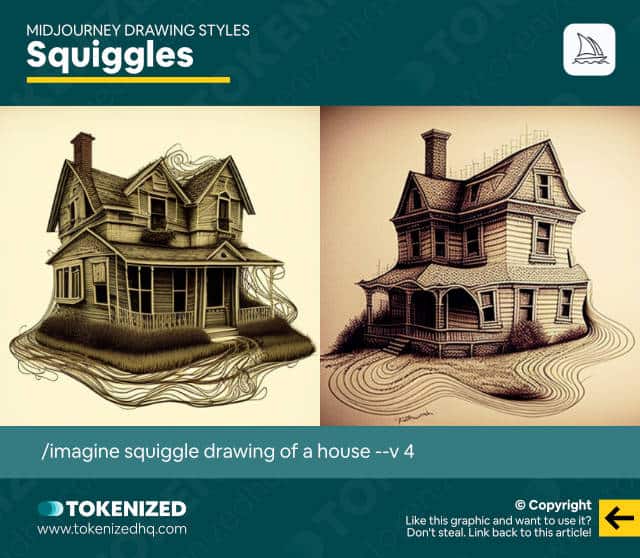
Both “squiggles” and “scribbles” are types of freehand drawing styles that use irregular lines to create texture and depth.
However, “scribbles” are usually made with short, overlapping lines, while “squiggles” are longer and looser, with less overlap.
Squiggles may also be used more intentionally, to create organic shapes and contours, while scribbles are often used for shading and texture.
Sample Prompt:
/imagine squiggle drawing of a house --v 4Short Dashes
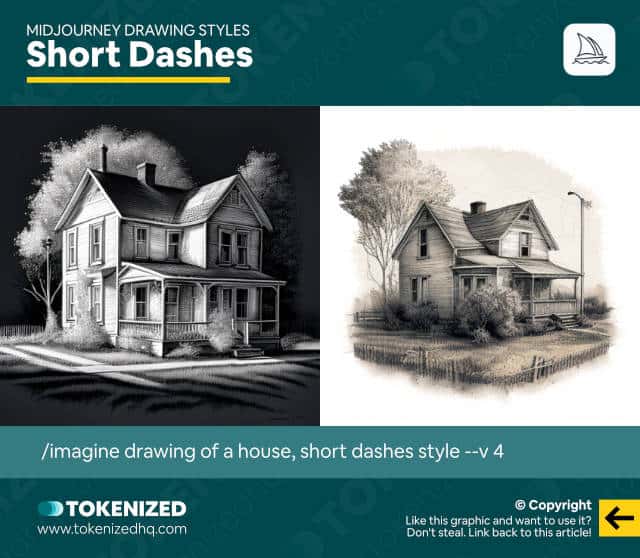
Short dashes is a drawing style that uses small, dashed lines to create texture and shading.
It can be used to create a variety of effects, from rough sketch-like drawings to more polished and refined artwork.
The dashed lines can be used to suggest movement, depth, and shape.
This style is often used in illustrations and cartoons, as well as in more realistic artwork to create the illusion of texture and depth.
Therefore, it is advisable to use this Midjourney drawing style for similar subjects.
Sample Prompt:
/imagine drawing of a house, short dashes style --v 4Blending & Smudging
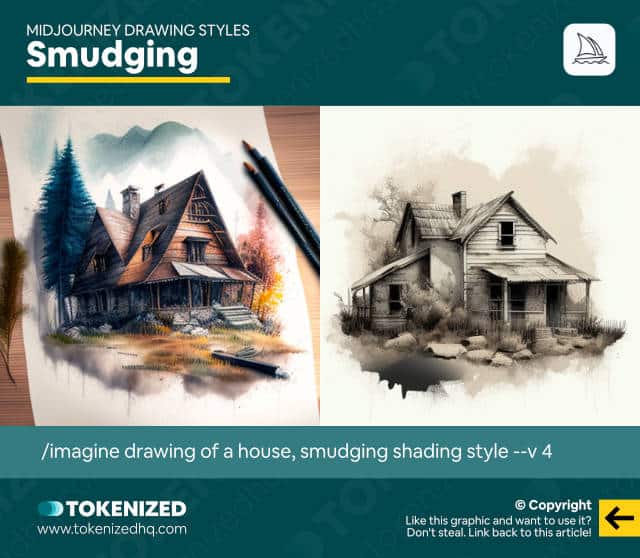
Blending and smudging is a drawing style that involves softening lines and colors to create a more realistic and subtle image.
It involves using tools such as blending stumps, brushes, and fingers to blend and smudge the lines and colors on the drawing surface.
This technique is often used in portrait drawing and is effective for creating a sense of depth and dimension in the image.
Sample Prompt:
/imagine drawing of a house, smudging shading style --v 43s

The “3s” drawing style involves using lines to create curves and shapes in the form of the number 3.
The lines are typically thin and close together, creating a shaded effect.
This style is often used in figure drawing, particularly to depict the contours of the human body.
Admittedly, it’s one of the more odd Midjourney drawing styles that you’ll encounter.
Sample Prompt:
/imagine drawing of a house, threes shading style --v 4Zig Zags
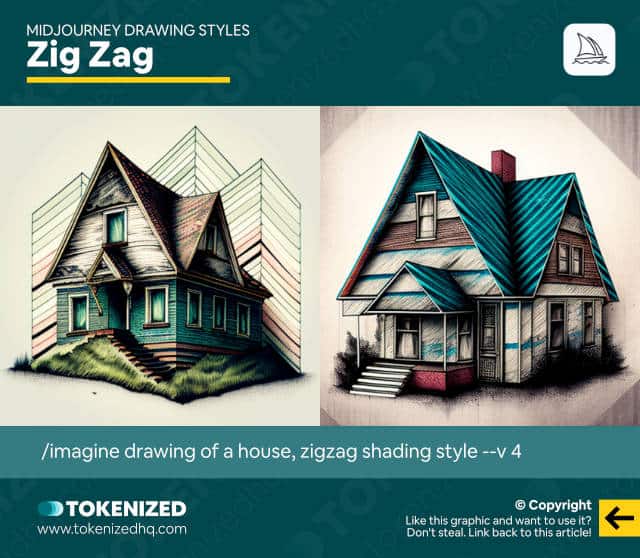
The zigzag Midjourney drawing style is characterized by the use of short, quick lines that zig and zag.
The lines are often tightly spaced and used to create texture and depth.
The style is often used in cartoons and comics to create a sense of motion and energy.
It can also be used to create shading and highlights.
Sample Prompt:
/imagine drawing of a house, zigzag shading style --v 4Charcoal
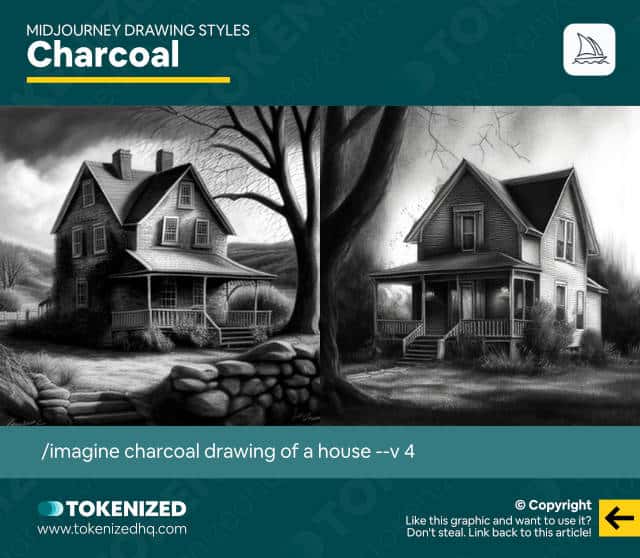
Charcoal is a dry art medium that creates rich, deep tones with a wide range of values.
It can be used in a variety of ways, including blending, hatching, and cross-hatching.
Charcoal can be messy to work with but can create a dramatic and expressive drawing style.
Sample Prompt:
/imagine charcoal drawing of a house --v 4Stippling
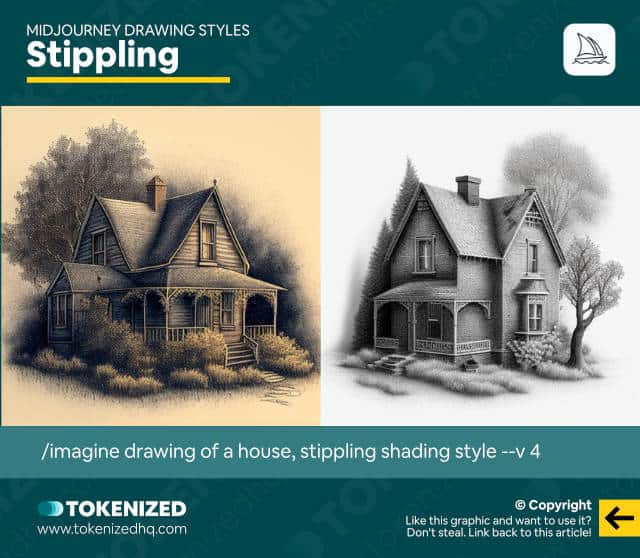
Stippling is a drawing style that uses tiny dots or marks to create texture, shading, and detail.
These marks can be uniform in size or vary in size and density to create different effects.
Stippling is often used in black-and-white illustrations, portraits, and technical drawings.
It’s a Midjourney drawing style that you rarely see invoked directly in the prompt.
Sample Prompt:
/imagine drawing of a house, stippling shading style --v 4Scumbling
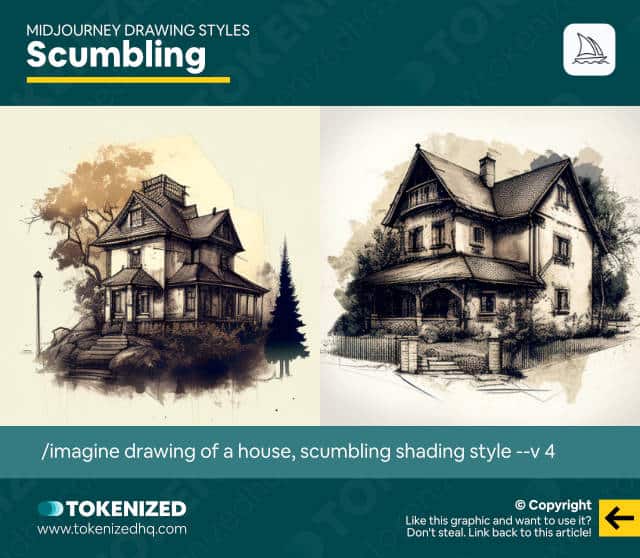
Scumbling is a drawing technique where you create a series of overlapping scribbles to create a shading effect.
The technique is often used to create the illusion of texture, depth, and dimension in a drawing.
Scumbling can be done with a variety of tools, including pencils, charcoal, and pastels.
Sample Prompt:
/imagine drawing of a house, scumbling shading style --v 4Marker
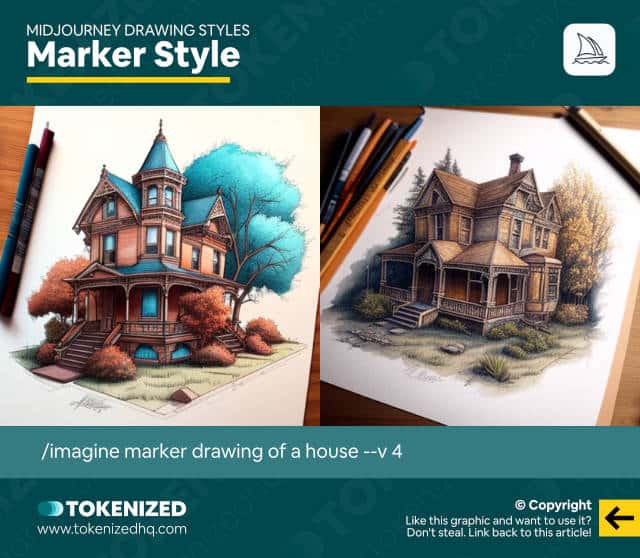
Marker drawing style is characterized by bright, bold colors that stand out on the page.
It often involves creating large, flat areas of color with thick, black lines outlining the shapes.
Markers come in a variety of sizes, allowing for both fine details and larger areas to be covered quickly.
Sample Prompt:
/imagine marker drawing of a house --v 4Japanese Ink
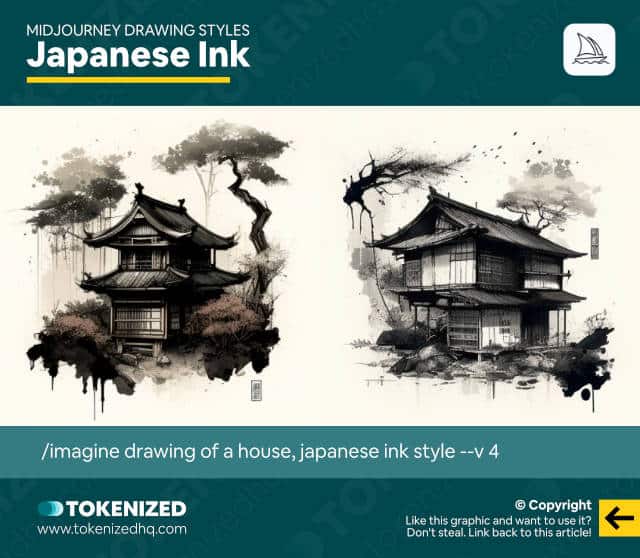
Japanese ink is known as sumi-e in Japan.
It is a black ink made from soot and water, often used for calligraphy and brush painting.
This drawing style focuses on capturing the essence of the subject rather than realistic representation.
The strokes and shades are created with a bamboo brush, giving a unique texture and character to the drawing.
Sample Prompt:
/imagine drawing of a house, japanese ink style --v 4Tattoo
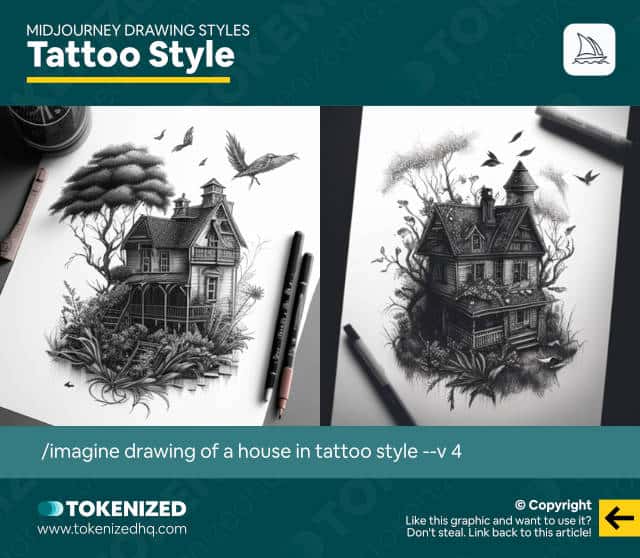
The tattoo drawing style is a permanent form of body art created with ink and needles.
Designs can range from traditional to more modern and abstract.
Tattoos can be placed on various parts of the body, and often hold personal significance or symbolism for the wearer.
Techniques such as shading, line work, and color blending are used to create depth and texture in the tattoo design.
Sample Prompt:
/imagine drawing of a house in tattoo style --v 4Applications & Relevance of Drawing Styles
Different drawing styles hold significant relevance in various fields today, including art and design, animation, storyboarding, engineering and construction, and education.
Here’s how these styles contribute to each industry:
Art & Design
Art and design extensively use a variety of drawing styles to create unique and engaging pieces.
For example, hatching and cross-hatching can be seen in graphic design to create texture and depth.
Contouring is employed in fashion design to highlight the shape and form of garments.
Abstract styles, such as scribbles, squiggles, or blending/smudging, are used to convey emotion and movement in fine art pieces.
Animation
In the animation industry, dynamic and expressive styles like squiggles, short dashes, or zig zags are used to create lively and energetic characters or scenes.
Styles such as charcoal or marker can lend a unique visual identity to an animation, setting it apart from others.
Storyboarding
Storyboarding is crucial in film and advertising and it relies on styles like sketching for quick, rough drawings that convey the sequence of events.
More detailed styles, like stippling or hatching, might be used for key frames to provide a visual representation of important scenes.
Engineering & Construction
Drawing styles play an integral role in engineering and construction for technical drawings and blueprints.
Contouring is essential for detailing the form and volume of structures.
Hatching and cross-hatching can represent different materials or shades in a blueprint.
Styles like sketching and marker are often used in preliminary design drafts.
Education
Educators use various drawing styles to create engaging teaching materials.
Stippling or blending/smudging can be used in science textbooks to illustrate complex concepts.
Styles like sketch or contour can be used in art education to teach students about basic drawing techniques.
In all these fields, the drawing styles available in Midjourney can be a valuable tool, allowing you to generate a wide range of images that suit your specific needs.
Frequently Asked Questions (FAQ)
Before we close off this guide, let’s quickly address some of the most common questions related to Midjourney drawing styles.
-
How do I add a style in Midjourney?
You cannot “add” a style to Midjourney. Instead, you reference the name of an art style within your prompt in order to generate images that use the art style you are looking for.
-
How do you use Midjourney for illustrations?
To create illustrations in Midjourney, you must first define the subject of your prompt and describe a scene. You then add descriptors to the prompt that trigger a particular art style, mood, or theme.
Conclusion
Just about anyone can create stunning artwork in Midjourney with very little previous experience.
However, the big differentiator is your ability to produce images with the intent that truly reflects the idea that you have in mind.
And knowing the names of specific drawing styles will set you apart from the broad masses that do not.
Here at Tokenized, we want to help you learn as much as possible about the AI software industry. We help you navigate the world of tech and the digitalization of our society at large, including the tokenization of assets and services.



